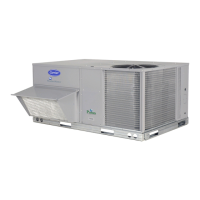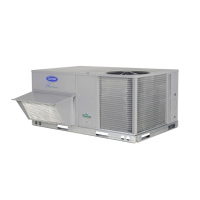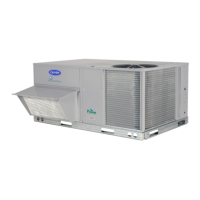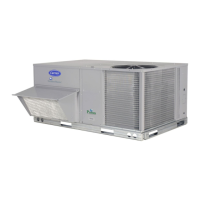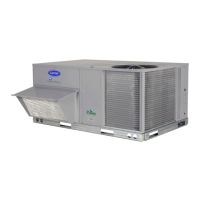33
Power Exhaust (output) —
Connect the accessory Power Exhaust contactor coils(s)
per Fig. 53.
J8-3
15
C
TB1
PL
PEC
TAN
GRA
Power Exhaust
CTB
THERMOSTAT
C08120
Fig. 53 − PremierLink Controller Power Exhaust
Output Connection
CCN Communication Bus —
The PremierLinkt controller connects to the bus in a
daisy chain arrangement. Negative pins on each
component must be connected to respective negative pins,
and likewise, positive pins on each component must be
connected to respective positive pins. The controller
signal pins must be wired to the signal ground pins.
Wiring connections for CCN must be made at the 3−pin
plug.
At any baud (9600, 19200, 38400 baud), the number of
controllers is limited to 239 devices maximum. Bus length
may not exceed 4000 ft, with no more than 60 total
devices on any 1000−ft section. Optically isolated RS−485
repeaters are required every 1000 ft.
NOTE: Carrier device default is 9600 baud.
Communications Bus Wire Specifications: The CCN
Communication Bus wiring is field−supplied and
field−installed. It consists of shielded 3−conductor cable
with drain (ground) wire. The cable selected must be
identical to the CCN Communication Bus wire used for
the entire network.
See Table 11 for recommended cable.
Table 11 – Recommended Cables
MANUFACTURER CABLE PART NO.
Alpha 2413 or 5463
American A22503
Belden 8772
Columbia 02525
NOTE: Conductors and drain wire must be at least 20
AWG, stranded, and tinned copper. Individual conductors
must be insulated with PVC, PVC/nylon, vinyl, Teflon*, or
polyethylene. An aluminum/polyester 100% foil shield and
an outer jacket of PVC, PVC/nylon, chrome vinyl, or Teflon
with a minimum operating temperature range of −20_C to
60_C is required. Do not run communication wire in the
same conduit as or next to any AC voltage wiring.
The communication bus shields must be tied together at
each system element. If the communication bus is entirely
within one building, the resulting continuous shield must
be connected to ground at only one single point. If the
communication bus cable exits from one building and
enters another building, the shields must be connected to
the grounds at a lightning suppressor in each building (one
point only).
Connecting CCN bus:
NOTE: When connecting the communication bus cable,
a color code system for the entire network is
recommended to simplify installation and checkout. See
Table 12 for the recommended color code.
Table 12 – Color Code Recommendations
SIGNAL TYPE
CCN BUS WIRE
COLOR
CCN PLUG PIN
NUMBER
+ Red 1
Ground White 2
- Black 3
Connect the CCN (+) lead (typically RED) to the unit’s
TB1−12 terminal. Connect the CCN (ground) lead
(typically WHT) to the unit’s TB1−14 terminal. Connect
the CCN (−) lead (typically BLK) to the unit’s TB1−16
terminal. See Fig. 54.
CCN Bus
J2-1
J2-2
GND (WHT)
12
14
TB1
J2-3
– (BLK)
16
TB1
TB1
PL
+ (RED)
C08276
Fig. 54 − PremierLink Controller CCN Bus
Connections
* Teflon is a registered trademark of DuPont.
50HCQ

